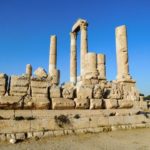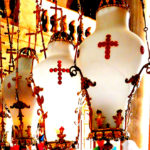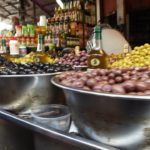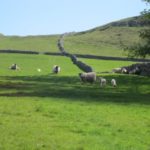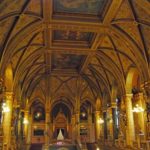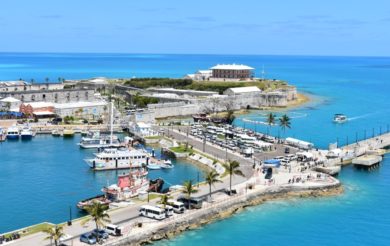Travel Israel – Walking in the Footsteps of Jesus
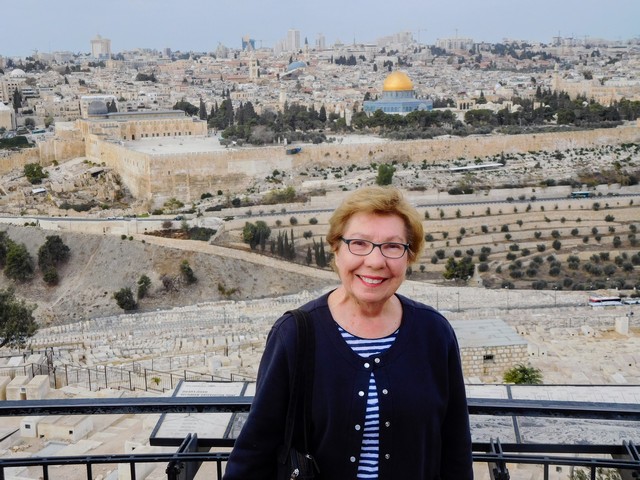
Travel Israel – Walking in the Footsteps of Jesus by Elizabeth von Pier
Travel Israel – Walking in the Footsteps of Jesus
“How to Spend Six Hours in Jerusalem”
by Elizabeth von Pier
I am spending ten days in Jordan and decide to take a day trip from my hotel in Amman to Jerusalem so that I can continue the walk in Jesus’ footsteps that I started here in Jordan. I dunk my foot in the River Jordan where Jesus was baptized and look out over the Promised Land from the top of Mount Nebo, then travel by car throughout Jordan admiring the magnificent landscape.
I see the canyons and deserts where Bedouins live like Jesus did 2,000 years ago, traveling on the backs of camels, herding sheep and goats, living in tents and moving from place to place as the weather changes.
As night falls, the north star shines just like the Star of Bethlehem did when Mary gave birth to Jesus in a stable, and while I’m not on a donkey or camel, it follows me throughout my journey in my car, almost as if it were guiding me to my destination. I ponder in amazement at the coincidence.
MEDITATING ON THE MOUNT OF OLIVES
I have crossed the border into Israel and am now standing on the Mount of Olives looking out at the views over the walled Old City of Jerusalem. Compared to the barbed wire, lookout towers and guards with machine guns patrolling the border, this is beautiful and all seems peaceful. The gold-plated Dome of the Rock on Temple Mount, an enduring symbol of the city, stands magnificently above all else.
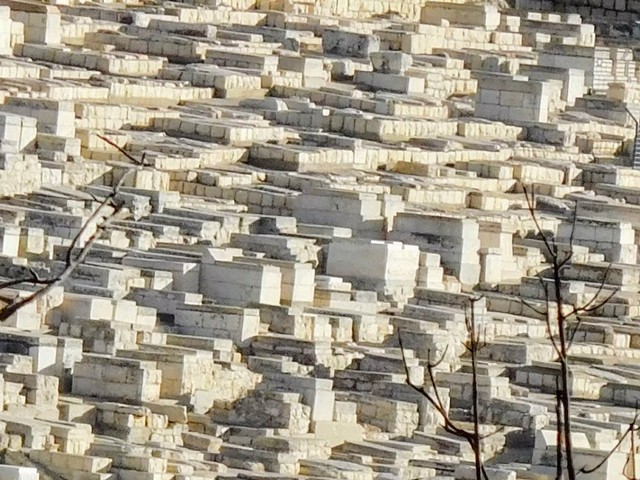
Jewish Cemetery in Jerusalem
Below me on the hillside is the Jewish cemetery, one of the largest in the world. For over 3,000 years, some 150,000 Jews from all over the world have been laid to rest here, one right next to the other. It is a very popular site because, according to the Bible, this is where the resurrection of the dead will start when the Messiah returns on Judgment Day. The Jews, I am told, want to be first in line.
The dead here are buried above the ground in large box-like stone memorials. There is barely room to walk between the graves, and families and friends honor the dead by leaving a small stone instead of flowers. It is a popularity contest of sorts—the more stones, the more the visitors. Being made of a cement-like material, the graves are all the same white color and sit crowded together on the hillside, blazingly bright in the sunlight. It looks surreal, like a modern Cubist painting. Some have many stones left by visitors, others none at all.
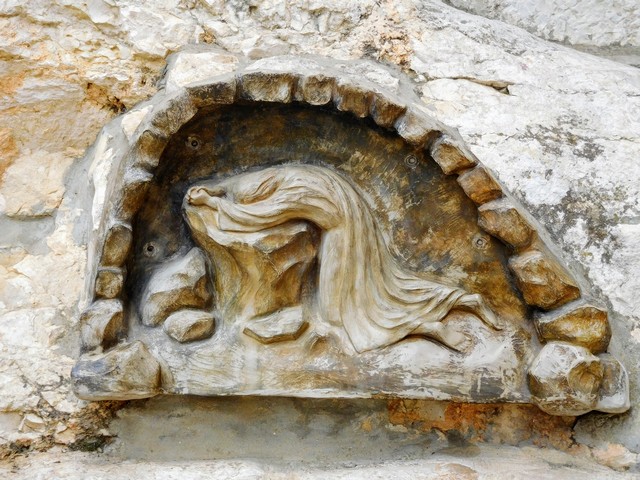
Church Of All Nations
The Garden of Gethsemane is, even today, a peaceful and quiet place. Supposedly this is the very garden where Jesus prayed and was arrested after having the last supper with his disciples. The sun disappears for a moment and it’s raining softly, almost like tears from above. There are ancient and twisted olive trees, some probably dating from the time when Jesus prayed here, and the prayerful are praying. The Church of All Nations is right beside the garden and commemorates the place where Jesus knelt on the rock to pray.
The Russian Chapel of the Ascension with its needle point steeple is located in a narrow alley among the shops on top of the Mount of Olives. The Russian Orthodox Church believes that this is the spot from which Jesus ascended into heaven.
THE “CENACLE”, ROOM OF THE LAST SUPPER
The arched hall that I enter is in a 12th century building built by the Crusaders so it couldn’t actually be in the present room where Jesus and his disciples had their last supper together. It is possible though that the present building stands over or near the original site; the actual site of the last supper is not known. For a period this building was used as a mosque by the Ottomans who created the lovely stained glass windows with Arabic inscriptions. King David’s tomb is located in the room below and there is a statue of the King outside in the courtyard. This is another very holy place in Jerusalem.
THE WAY OF THE CROSS ON VIA DOLOROSA, THE “PATH OF SORROW”
We enter the Muslim Quarter of the Old City of Jerusalem via the Damascus Gate and wander through the maze of streets. I wonder if my guide really knows where to lead me in this tangle of ancient streets and bazaars. There are money changers, trinket shops, food stalls filled with luscious fruits, vegetables and herbs, and children playing “catch me if you can”.

Gate of the Old City
Boys are pushing heavy carts of water and milk, standing on rubber tires attached to the back of the carts which they use to brake the pace when heading downhill. You can buy almost anything here, from water pipes to perfumes to spices and Saudi dates. It’s a very lively place and a feast for the senses, similar to the medinas in many Middle Eastern cities.
We finally find the Via Dolorosa, the “Path of Sorrow”, also called The Way of the Cross. This is a half mile route that memorializes the events of Jesus’ last day. Every Friday at 3:00 the Franciscans lead a procession along this route and all pilgrims are invited to join. It’s not Friday, but my guide and I start here in the Muslim quarter where Jesus was condemned to death by Pontius Pilate and whipped. This part of the route includes the first nine “stations of the cross”, is narrow, often hilly, and uneven with cobblestones. It’s not the quiet path that I had envisioned, being crowded with shops and stalls and bustling with activity which compete for the attention of pilgrims.
Each station is marked with a round bronze plaque engraved with roman numerals; some have small chapels attached to them. I’m glad I have my guide with me to lead the way because not all are easy to find. I try to close out the distractions of the busy area surrounding these holy places and imagine Jesus here on His final journey. As with many of the sites I’m seeing here in Jerusalem, experts say that it is likely that these plaques do not mark spots on the actual walk He took, but they do think this is the general area. It is one of the holiest sites in Christianity.
SANCTITY OF THE CHURCH OF THE HOLY SEPULCHRE
The Way of the Cross ends at the site of Calvary in the Christian quarter, inside the Church of the Holy Sepulchre. Here the last five stations are memorialized and I pause at the places where Jesus was stripped of his garments, nailed to the cross, died, and was taken down from the cross. Then I stand in a long line to see the stone where He was laid to rest in the tomb.
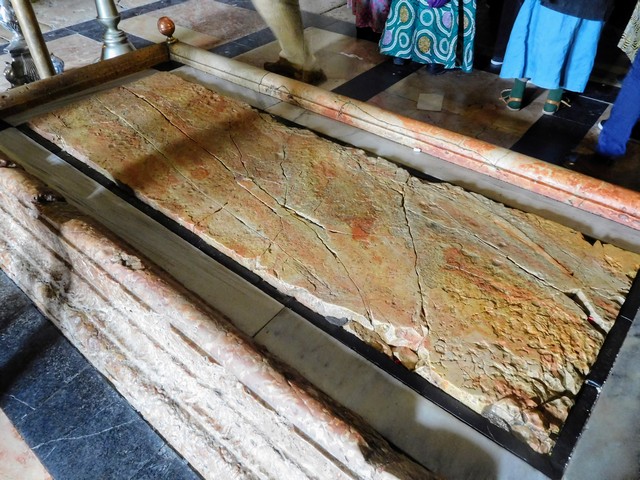
Holy Sepulchre
The church building itself was built and consecrated in 335, and was rebuilt and redecorated during the Byzantine Empire in the 11th century. It is owned by several denominations including the Roman Catholics, Greek Orthodox, Armenian Orthodox, and to a lesser extent by the Egyptian Copts, Syriacs and Ethiopians. It’s an extremely holy place and very busy, with pilgrims from all over the world praying, weeping and meditating.
TOMB OF THE VIRGIN MARY
Located just down from the Mount of Olives, this is another one of the holiest sites in Christianity. It is a dim and pitifully sad place identified as the place where Mary died in the middle of the 1st century. A memorial was first constructed here in the 5th century, but the current building is newer, dating from the 12th century period of the Crusades. Stairs lead down into the crypt and hundreds of dusty ancient lanterns hang from the ceiling. I wait my turn to go into the tiny cave-like room where there is a stone set into the wall behind glass. This is where Mary was laid to rest.
IN THE MUSLIM AND JEWISH QUARTERS
Jerusalem is a holy place to three great faiths—Christianity, Judaism and Islam—and, while I spend a lot of my time following the Via Dolorosa, there are sections of the Old City that are devoted to all of them. The Muslim quarter with its cobbled walkways and labyrinth of narrow passages and ancient alleys and vendor stalls has the Temple Mount, the Dome of the Rock, and the Al-Aqsa mosque.
The Jewish Quarter has the Western Wall, Judaism’s holiest place, and the Christian quarter has the Church of the Holy Sepulchre. There’s also an Armenian Quarter but this is mainly a residential area with children playing in the streets, laundry flapping from the windows, and women carting home goods they bought from the street vendors.
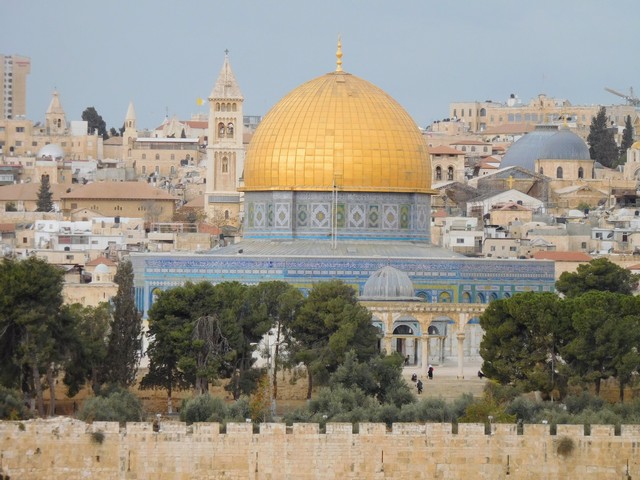
Dome Of The Rock
I leave Jerusalem feeling enriched and thankful that I have been privileged to visit some of the holiest places on earth—and perhaps a bit more religious.
IF YOU GO:
- Sheraton Amman Al Nabil Hotel, 5th Circle, Amman, 11184 Jordan.
- Monther Salah (for taxi and tour of Jerusalem), 0544655387 or +972544655387. Monther is first and foremost a taxi driver and secondly a tour guide. He knows his way around the Old City of Jerusalem very well and will point out all of the sights. However, you should have a guidebook with you to fill in the details.
BORDER FORMALITIES:
This is a bit more than I had bargained for. I meet my driver in the lobby of the hotel. The drive to the Allenby/King Hussein Bridge on the border of Jordan and Israel takes about one hour and there are checkpoints along the way where I have to show my passport. Arriving at the border, security becomes very tight and the lines are slow.
My Jordanian driver announces that he is leaving me here and that I will be met on the “other side” by my Israeli guide and driver. I panic silently and quickly attach myself to a group of European tourists who don’t seem to know what is going on either. There is comfort in the affiliation. The security equipment here is extremely sensitive and I am asked if I have a gun. I learn quickly that I should not let them stamp my passport at either border because, tensions being what they are in the Middle East, evidence of a visit to Israel in your passport will bar you from entering a number of countries in the region.
Next, I get on a bus that takes me the five kilometers to the Israeli checkpoint where I again go through tight security. After a phone call or two, I finally find the taxi driver who will be my guide in Jerusalem. I am surprised to learn that, on the way back, I will have to pay 51 U.S. dollars for a return visa into Jordan. These procedures were in place in late 2016, but I am told that rules and regulations are subject to change.
BIO:
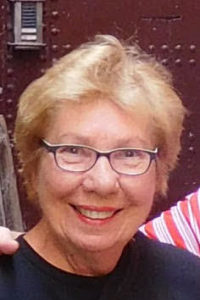
Elizabeth von Pier
Elizabeth von Pier loves to travel. After she retired from her lifetime career in banking, she started traveling regularly, photographing the sights she saw, and writing about her experiences. She has been published in In the Know Traveler, Go Nomad, WAVEJourney, Hackwriters, Travelmag—The Independent Spirit, and Travel Thru History.

